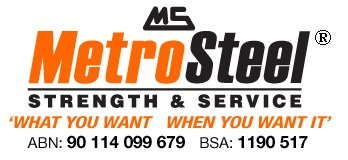In recent years, technological advances in metal fabrication have seen huge improvements in metal cutting. As a result, diverse industries and services including construction, agriculture, aerospace, military and defence, mining and equipment manufacturers rely on metal cutting and fabrication to complete their projects.
There are several precision metal cutting techniques available, and each has its own advantages. This is why it’s so important to choose the best method for your product in order to obtain a quality finished product. The main methods we use at Metro Steel include punching and laser cutting.
Punching
This type of metal cutting is generally used for cutting holes and creating cut-outs of various sizes, shapes, and dimensions from sheet metal. The process is achieved by a shearing force which removes material from the sheet leaving behind a rectangle, circle, or other desired geometric shape.
A punch press is used for mass production and as its name might suggest, shapes and cuts the metal as it passes beneath a press. The procedure requires a punching press, a punch tool, a die in the shape of the feature, and a stock of sheet metal. Using CNC or Computer Numerical Control, the metal sheet is placed on the conveyor, sandwiched between the punch press above and the die beneath to perform a cutting action.
Punched metal can leave a few rough snags which may need to be smoothed in a minor finishing operation, but overall the cut is precise. The sheet metal commonly used for punching depends on the application but can include:
- Stainless steel
- Carbon steel
- Aluminium
- Galvanised steel
- Copper
Laser cutting
If you’re looking for a cost-effective method of precision metal cutting, then it has to be laser cutting. It’s quite different from other forms of cutting machines, with the main difference being that the laser does not come into contact with the metal being cut. Instead, a high energy powered beam of light cuts the metal via an automated program.
Laser cutting can be used on a wide range of material thicknesses and is well suited to carbon steel and stainless steel. Furthermore, it can produce more complex designs and shapes and trim materials to an exact specification far better than a typical punch press.
Plasma Cutting
This method can be used for cutting both thin and thick metal sheets. It’s achieved by utilising a localised accelerated jet of hot plasma with air or assisted gas, which creates a clean even cut without warping or distortion. Metals commonly cut in this way include
- Steel
- Stainless steel
- Copper
- Brass
- Aluminium
The benefits of plasma cutting include low costs, faster production speeds, and precision across a wide range of applications. That said, it is not as accurate as water jet or laser cutting.
Water Jetting
This method of metal cutting is both efficient and versatile and produces a clean cut while barely any machining is necessary to prepare the metal. The process utilises high velocity and pressure to create an intense cutting stream of water which is propelled through a small orifice (often stone). It’s very quick but not as precise as laser cutting. However, it’s a good choice for cutting both standard and exotic metals, including
- Copper
- Aluminium
- Bronze
- Tungsten
- Stainless steel
- Titanium
To learn more about our metal cutting capabilities please contact the experts at Metro Steel on 07 3204 1000.
 Talk to an Expert (07) 3204 1000
Talk to an Expert (07) 3204 1000 Working Hours - Mon – Fri 7:00 AM – 4:00 PM
Working Hours - Mon – Fri 7:00 AM – 4:00 PM